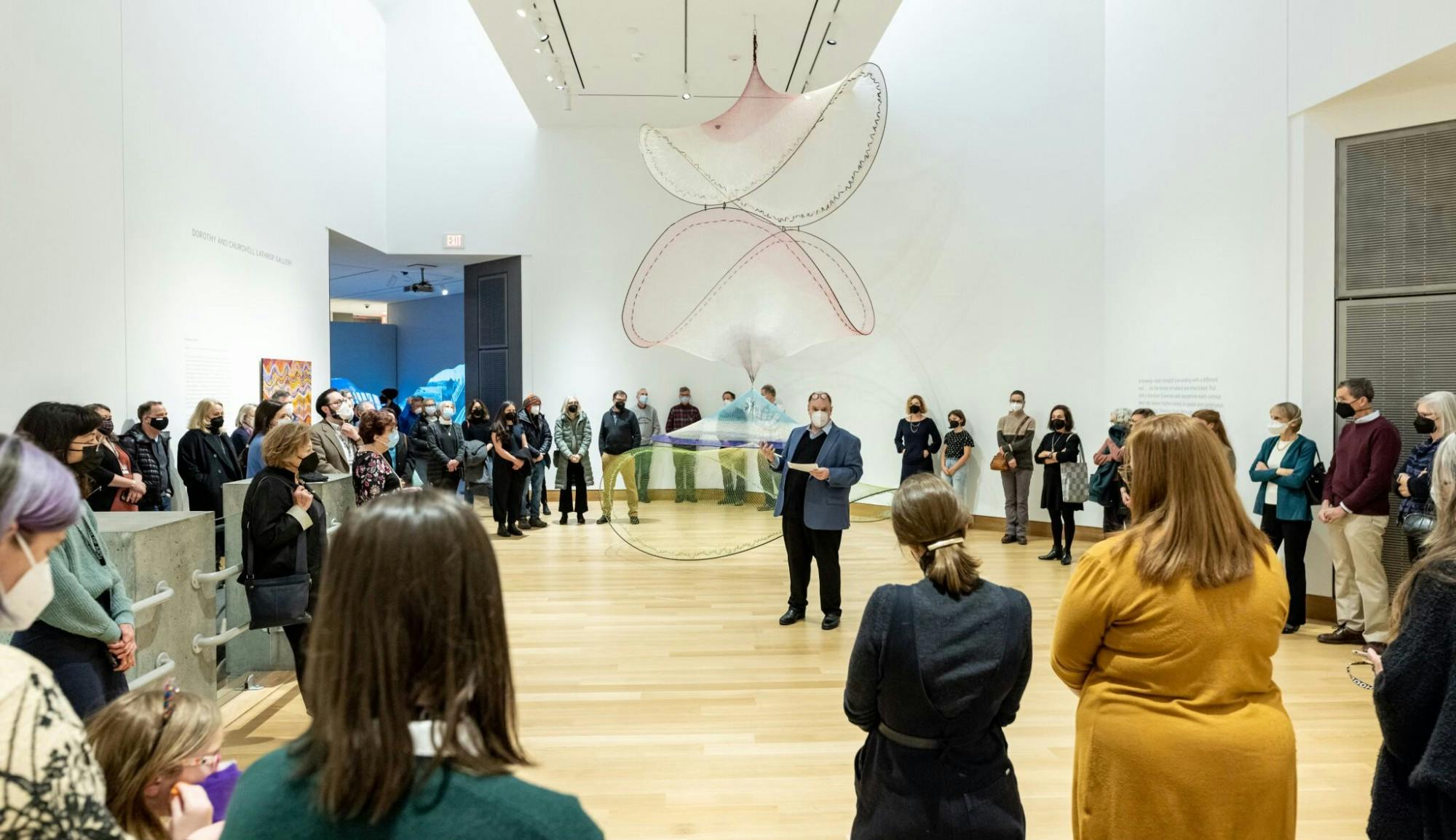The Hood Museum of Art welcomed the Upper Valley community back into its space with two new exhibits on Thursday, Feb. 24. The event emphasized the Hood’s community connectivity, according to curator of Indigenous art Jami Powell.
The Hood has been open to the general public since Jan. 1, but the winter reopening celebration helped to reintegrate Upper Valley residents back into the Dartmouth community, according to Powell.
“The College has remained separate from the Upper Valley [since the beginning of the pandemic],” she said. “A lot of people didn’t know that the museum was open to the public and not just for the Dartmouth community.”
The event included live music in the Russo atrium, opportunities to speak with one of the exhibiting artists, and museum curators ready to answer questions about the exhibits. Campus engagement intern Alice Crow ’22 said she hopes that the event might help people feel more connected to the museum.
“Sometimes [when] people talk about art museums they say, ‘I’d go but I don’t really get it,’ which makes me sad because it can be whatever you want it to be, you don’t need to understand it,” Crow said. “But it can be nice for people to [talk to] someone who has a little bit more background.”
In addition to the labels that accompany each piece and provide context, the reception provided visitors with the opportunity to ask professionals any questions they may have.
Among the new exhibits highlighted during the event was curated by Amelia Kahl ’01, curator of academic programming, to showcase artist Louise Hamlin’s work in the show “In The Moment.” Louise Hamlin, who was at the reception talking to visitors, taught in the Dartmouth studio art department from 1990 until 2019. Kahl said she and Hamlin began planning Hamlin’s exhibit in 2020 shortly after Hamlin’s retirement. During her time as a professor, Hamlin often took advantage of the museum as a resource and would bring her classes to visit four or five times a term.
“I had such a lovely working relationship with [Hamlin] that I volunteered to curate that show,” said Kahl. “It was a pleasure while everything was locked down to visit Louise’s studio and to see her work.”
“In The Moment” mainly showcases paintings but also includes some prints and drawings. Hamlin spends the warmer months outside painting New England landscapes and the winter in her studio painting still lifes. Kahl was especially interested in showing off Hamlin’s still life paintings of microgreens as well as her landscape paintings of fog.
“What was particularly compelling to me was these fog paintings — this play with substances and materiality,” Kahl said. “So, what is fog? How do you paint fog? How do you experience fog? We see it, it seems present, but we can't hold it. So how do you paint something that is visibly there but also insubstantial at the same time? [Hamlin’s paintings] are as much about the experience [of being in the moment] as they are about the tradition of the New England landscape.”
Alongside “In The Moment is This Land: American Engagement with the Natural World,” curated by Jami Powell, curator of Indigenous art; Morgan Freeman, former Diversifying Art Museum Leadership Initiative Native American Art Fellow; Tom Price, curatorial assistant; Bonnie MacAdam, former curator of American art; and her successor Michael Hartman, curator of American art, depicting the relationships that Americans have with the natural world, according to Powell. The exhibit features Native American and American art, and is the first show in which the Hood museum has placed art created by Native Americans and non-Native American artists alongside one another in the same exhibit.
“For a long time, Native American art was not collected as art, it was collected by Anthropologists as ethnographic, so there’s been this divide between art and craft,” Powell said. “We’re challenging in this exhibition these arbitrary distinctions and categories that frame the way we present work and elevate all of the work so that it can be presented on equal terms. Throughout the exhibition you’ll notice we’ve tried hard to place the work[s] in conversation with one another.”
Powell and MacAdam began working on this show three years ago, when MacAdam approached Powell about including a few Indigenous pieces in an exhibition that looked at interpretations of the natural world.
“We weren’t sure what it was going to look like, so I was pleasantly surprised by how well [American and Native American art] pair aesthetically,” Powell said. “The Georgia O'Keefe painting of the Taos Mountains is hung next to a Diné saddle blanket that’s an abstraction of mountains; you’ll actually see that they’re depicting the same landscape.”
Powell said one of their goals was to illustrate the complex history of America, addressing colonialism, racism and segregation within American art history.
“[It] can also be an opportunity to think about how we want to tell these stories moving forward and the kind of narratives we can construct and the futures that artists can help us imagine if we open ourselves up to grappling with that complexity,” Powell said.
Anne Wilson, a Hanover local, attended the re-opening and said she was glad to have the museum, which she missed during its closure to the community, back open.
“It was like there was a dark empty space where there was once life,” Wilson said. “No other small town has this wealth of art that Hanover has.”
Dan Bernstein ’87, who lives part time in Hanover and part time in New York, believes having access to the Hood is one part of what makes living in Hanover special.
“The Hood is the cultural beating heart of the community,” Bernstein said. “There’s lots of culture in New York, but you’re just part of a larger crowd. This is personal — sometimes you get to meet the artist, it’s more about community.”




